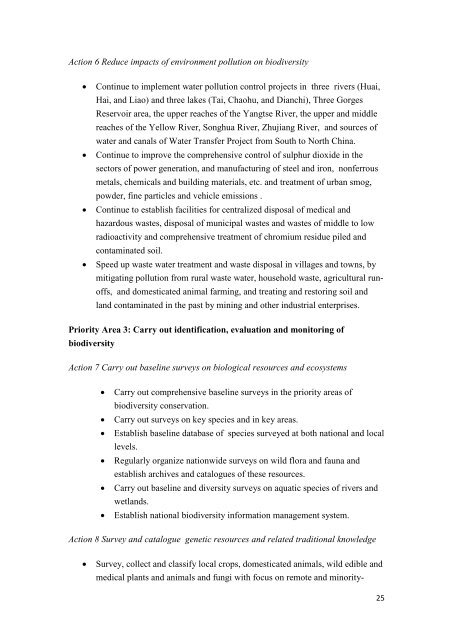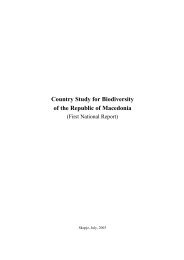English version - Convention on Biological Diversity
English version - Convention on Biological Diversity
English version - Convention on Biological Diversity
You also want an ePaper? Increase the reach of your titles
YUMPU automatically turns print PDFs into web optimized ePapers that Google loves.
Acti<strong>on</strong> 6 Reduce impacts of envir<strong>on</strong>ment polluti<strong>on</strong> <strong>on</strong> biodiversity<br />
<br />
<br />
<br />
<br />
C<strong>on</strong>tinue to implement water polluti<strong>on</strong> c<strong>on</strong>trol projects in three rivers (Huai,<br />
Hai, and Liao) and three lakes (Tai, Chaohu, and Dianchi), Three Gorges<br />
Reservoir area, the upper reaches of the Yangtse River, the upper and middle<br />
reaches of the Yellow River, S<strong>on</strong>ghua River, Zhujiang River, and sources of<br />
water and canals of Water Transfer Project from South to North China.<br />
C<strong>on</strong>tinue to improve the comprehensive c<strong>on</strong>trol of sulphur dioxide in the<br />
sectors of power generati<strong>on</strong>, and manufacturing of steel and ir<strong>on</strong>, n<strong>on</strong>ferrous<br />
metals, chemicals and building materials, etc. and treatment of urban smog,<br />
powder, fine particles and vehicle emissi<strong>on</strong>s .<br />
C<strong>on</strong>tinue to establish facilities for centralized disposal of medical and<br />
hazardous wastes, disposal of municipal wastes and wastes of middle to low<br />
radioactivity and comprehensive treatment of chromium residue piled and<br />
c<strong>on</strong>taminated soil.<br />
Speed up waste water treatment and waste disposal in villages and towns, by<br />
mitigating polluti<strong>on</strong> from rural waste water, household waste, agricultural runoffs,<br />
and domesticated animal farming, and treating and restoring soil and<br />
land c<strong>on</strong>taminated in the past by mining and other industrial enterprises.<br />
Priority Area 3: Carry out identificati<strong>on</strong>, evaluati<strong>on</strong> and m<strong>on</strong>itoring of<br />
biodiversity<br />
Acti<strong>on</strong> 7 Carry out baseline surveys <strong>on</strong> biological resources and ecosystems<br />
<br />
<br />
<br />
<br />
<br />
<br />
Carry out comprehensive baseline surveys in the priority areas of<br />
biodiversity c<strong>on</strong>servati<strong>on</strong>.<br />
Carry out surveys <strong>on</strong> key species and in key areas.<br />
Establish baseline database of species surveyed at both nati<strong>on</strong>al and local<br />
levels.<br />
Regularly organize nati<strong>on</strong>wide surveys <strong>on</strong> wild flora and fauna and<br />
establish archives and catalogues of these resources.<br />
Carry out baseline and diversity surveys <strong>on</strong> aquatic species of rivers and<br />
wetlands.<br />
Establish nati<strong>on</strong>al biodiversity informati<strong>on</strong> management system.<br />
Acti<strong>on</strong> 8 Survey and catalogue genetic resources and related traditi<strong>on</strong>al knowledge<br />
<br />
Survey, collect and classify local crops, domesticated animals, wild edible and<br />
medical plants and animals and fungi with focus <strong>on</strong> remote and minority-<br />
25
















